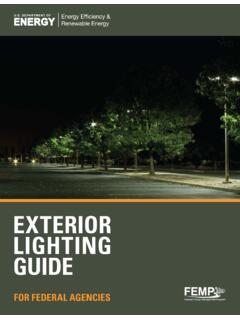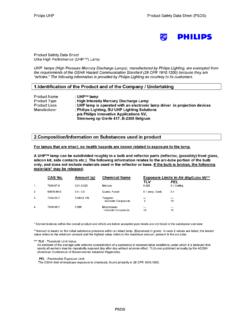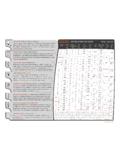Transcription of 2013 TITLE 24, PART 6 LIGHTING FOR OFFICE APPLICATIONS
1 LIGHTING FOR OFFICE APPLICATIONS2013 TITLE 24, part 6A guide to meeting, or exceeding, California s 2013 Building Energy Efficiency StandardsDEVELOPED BY THE CALIFORNIA LIGHTING TECHNOLOGY CENTER, UC DAVISThis guide is designed to help builders and LIGHTING industry professionals become more familiar with the OFFICE nonresidential LIGHTING portion of California s 2013 Building Energy Efficiency Standards ( TITLE 24, part 6).The guide provides information on current LIGHTING technologies, LIGHTING design terms and principles, and best-practice recommendations. It is designed to complement LIGHTING courses developed through CLTC and sponsored by Pacific Gas and Electric Company through its Energy Education program. 2015, Regents of the University of California, Davis campus, California LIGHTING Technology CenterGuide Prepared by: California LIGHTING Technology Center (CLTC) University of California, Davis 633 Pena Drive Davis, CA 95618 Partners: California Energy Commission Pacific Gas and Electric Company1 | THE COMPLIANCE PROCESSThe Compliance Process.
2 8 Indoor LIGHTING Compliance Documents ..10 New in 2013: An Overview of Updates ..12 Finding Compliant Products ..132 | TECHNOLOGY OVERVIEWC oncepts and Principles ..16 Light Sources ..20 Replacement Options for Linear Fluorescents ..22 Control Strategies ..23 Control Architectures ..253 | COMPLIANCE REQUIREMENTS Navigating TITLE 24, part 6 ..28 Additions, Alterations & Modifications-in-Place ..30 Mandatory LIGHTING Controls Measures ..34 Performance Approach ..43 Prescriptive Approach ..44 Prescriptive Approach in Practice ..504 | DESIGNING TO CODEL ayered LIGHTING ..60 Ambient LIGHTING ..61 Managing Daylighting ..62 Task LIGHTING ..63 Controls in Transitional Spaces ..645 | APPENDIXG lossary ..67 Tables ..72 Resources ..78 CONTENTS2013 TITLE 24, part 6: LIGHTING FOR OFFICE APPLICATIONSPHOTO: CREE, TITLE 24, part 64 THE BENEFITS OF EFFICIENCYB igger Energy SavingsMaking OFFICE buildings more energy efficient reaps benefits including environmental and cost savings.
3 The LIGHTING requirements of California s TITLE 24, part 6 Building Energy Efficiency Standards are aimed at reducing energy use while maintaining high-quality buildings, which include OFFICE buildings, are one of the largest energy users in the United States. Today s commercial buildings consume 36% of energy, release 18% of carbon dioxide emissions and cost more than $190 billion in energy each year, according to the Department of Energy s OFFICE of Energy Efficiency & Renewable buildings make up the largest sector of building type within the commercial sector, comprising 17% of all commercial buildings in the and 19% of the energy, according to the DOE s Buildings Energy Data Book. In 2010, commercial interior LIGHTING accounted for nearly 49% of California s LIGHTING energy The potential to reduce energy consumption in existing and commercial buildings is enormous. On average, 30% of the energy used in commercial buildings is wasted, according to the Environmental Protection Agency.
4 LIGHTING has the largest potential for energy savings for any building end use, with a significant fraction of that potential coming from LIGHTING controls, which including occupancy, daylighting, institutional tuning, and personal of the drivers influencing the installation of LIGHTING controls are energy code requirements, green building design, energy efficiency, and safety and Jackson, Cori and Konstantinos Papamichael. (California LIGHTING Technology Center, University of California, Davis). 2014. LIGHTING Electricity Use in California Baseline Assessment to Support AB 1109. California Energy Williams, Alison A., Barbara A. Atkinson, Karina Garbesi, and Francis M. Rubinstein. 2012. (Lawrence Berkeley National Laboratory). Quantifying National Energy Savings Potential of LIGHTING Controls in Commercial 15 LIGHTING FOR OFFICE APPLICATIONSD immable light sources paired with advanced LIGHTING controls reduce energy use while adding flexibility to LIGHTING designs.
5 Today s offices serve multiple functions and their LIGHTING needs may change. Smart LIGHTING systems allow employers to adjust LIGHTING quickly, maximizing the benefits of work stations while saving employee factors to consider in OFFICE LIGHTING design include human needs such as visibility, safety, and visual comfort; environmental and economic issues such as energy and equipment costs and sustainability; and how well the LIGHTING complements the building design. A successful LIGHTING design utilizes the right equipment to maximize visual comfort while reducing costs and the carbon of Use The LIGHTING technology and use trends are similar for the commercial and industrial sectors. These consumers are typically facility managers who are concerned about the lifetime costs of a product. LIGHTING products with high efficacy and long lifetimes are more popular despite higher initial costs. This is why linear fluorescent and high-intensity discharge (HID) submarkets dominate these sectors, representing 80% and 99% of the installed lumen-hour base of commercial and industrial markets.
6 Light emitting diode (LED) products provide promise in reducing energy use in the commercial and industrial sectors whose consumers require long operating hour requirements and a high value on the annual costs of a LIGHTING Navigant Consulting, Inc., January 2012. Energy Savings Potential of Solid-State LIGHTING in General Illumination APPLICATIONS . Department of Energy, OFFICE of Energy Efficiency & Renewable : DAINTREE NETWORKS United Stationers Sacramento, CaliforniaUnited Stationers achieved a significant monthly LIGHTING savings of 94% by installing LED fixtures and Daintree s ControlScope smart building control solution at its Sacramento OFFICE facility. The new LIGHTING system allows them to see the status of their LIGHTING facility-wide via internet and provides maximum granular control along with automated ON / OFF switching, daylight and motion sensing to deliver dramatic energy savings while improving employee productivity and overall comfort.
7 The project results included: Pre-project wattage (fluorescent fixtures): OFFICE area: 21,672 watts Post-project wattage (LED fixtures): OFFICE area: 3,930 watts Total savings: 94% Savings attributable to ControlScope control system: 41%A case study is available at: uploads/2014/02 TITLE 24, part 66 INTRODUCTIONABOUT THIS GUIDEThis guide is designed to help builders, LIGHTING designers, contractors, and other end users become more familiar with the LIGHTING portion of California's 2013 TITLE 24, part 6 nonresidential standards as they apply to OFFICE spaces. It is designed to serve as a resource for LIGHTING industry professionals involved in the construction, maintenance, or retrofit of California s OFFICE buildings. The guide includes compliance requirements and recommendations for implementing the standards in new construction or renovation Compliance ProcessThe guide begins with an overview of the compliance process including the responsibilities, requirements and documentation involved in each phase of a project, from design to final OverviewThis section is devoted to LIGHTING concepts and principles such as color rendering, color temperature, light output, and lamp life.
8 These concepts are vital for making informed decisions about lamps, luminaires and portion of the guide also describes luminaire classification under the standards, control strategies, and control systems relevant to most OFFICE Requirements Mandatory code requirements related to electric LIGHTING , daylighting and LIGHTING controls in OFFICE buildings are explained in Chapter 4. This chapter also examines the prescriptive requirements of TITLE 24, part 6, including the available methods used to calculate allowed LIGHTING to CodeThis section of the guide includes recommendations for meeting and exceeding the LIGHTING standards in OFFICE APPLICATIONS . NOTE: This guide is not intended to be used in lieu of California s TITLE 24 Building Energy Efficiency Standards, and it is not a substitute for the code itself. Please visit / title24 to obtain the official 2013 TITLE 24 Building Energy Efficiency Standards, Errata, Reference Appendices, and the Nonresidential Compliance Manual.
9 To request a hard copy of the standards, contact the California Energy Commission s publications unit at (916) FOR OFFICE APPLICATIONSINTRODUCTIONTHE COMPLIANCE PROCESSThe following is an overview of the compliance process for nonresidential LIGHTING . Additional information and resources, including the 2013 Nonresidential Compliance Manual and forms may be found on the California Energy Commission website: Step 1: Comply with All Mandatory MeasuresAll nonresidential buildings must be designed and built to comply with the mandatory measures of TITLE 24, part 6. Step 2: Comply with All Prescriptive RequirementsIn addition to meeting the mandatory requirements, commercial buildings must also meet LIGHTING power density (LPD) requirements specified within the standards. Two approaches may be taken to meet these requirements: The Performance Approach provides one path to compliance. It requires using software approved by the Energy Commission and is best suited for use by experienced professionals familiar with TITLE 24.
10 This method allows for energy trade-offs between building systems. For example, under the performance approach, efficient LIGHTING can allow for a larger portion of the energy budget to be allocated to heating and cooling Prescriptive Approach does not require software or the same level of building design expertise as the Performance Approach. This guide focuses on the Prescriptive Approach. With this approach, designers may use one of the following methods to ensure each area of the OFFICE space is in compliance:Complete Building Method: The Complete Building Method may only be used in projects involving entire buildings with one primary use, or in mixed-use buildings or tenant spaces where 90% of the spaces have one primary Category Method: A single LIGHTING power allowance (LPA) is applied to all LIGHTING in a given space. Different OFFICE space types are allowed different Method: This detailed method is often used for retail APPLICATIONS , and rarely for OFFICE spaces.









